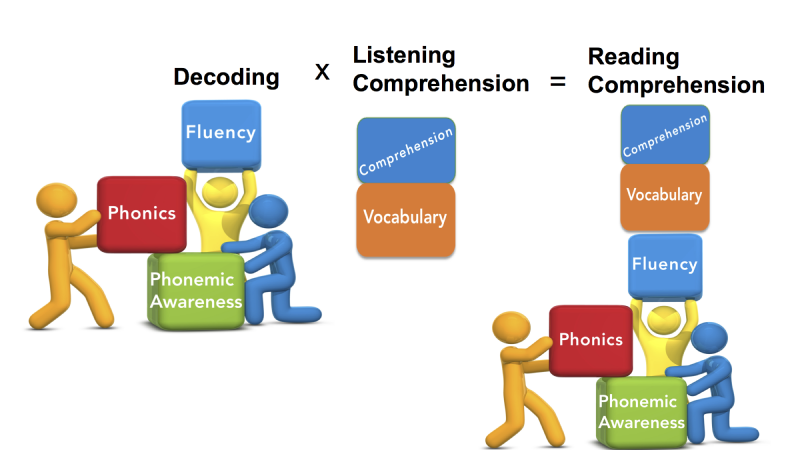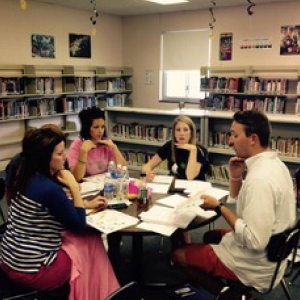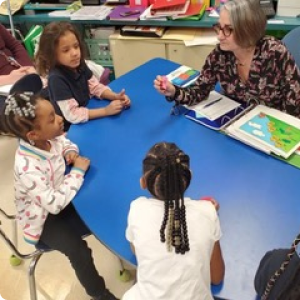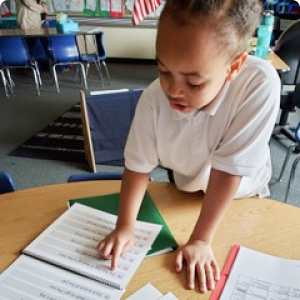PTR bridges the gap between research and the classroom helping to prevent reading difficulties before they begin in K-2 and addressing decoding needs of striving readers in grades 3 and above.
Research has identified the five key components of the reading process:
Phonemic Awareness
Phonics
Fluency
Vocabulary
Comprehension
In PTR these components are best expressed through the lens of the
Simple View of Reading.

Phonics and Fluency are the result of a strong foundation of Phonemic Awareness (the ability to discern the individual sounds of the spoken word). These components enable the development of independent decoding skills.
Accurate fluent decoding x a student’s ability to comprehend spoken language are both necessary to develop independent readers.
PTR’s continuum of instructional strategies progress from simple to complex establishing the foundational skills necessary for independent decoding and ensuring the transfer of those skills to decoding and comprehension in context. Teachers are taught to use multisensory techniques and effective questioning of student errors to develop independent readers.
Decoding and Comprehension are the core skills necessary for independent reading.
Figuring out the words
Phonemic awareness, phonics, and fluency are key skills necessary in learning to decode.
PTR strategies address each component in order to develop the independent, fluent decoding necessary for reading comprehension.


Understanding the meaning
Reading is more than decoding words. A student’s ability to interact and make connections with text is key to being a successful reader.
PTR is designed to interface with programs focused on comprehension such as Reader’s Workshop. PTR also offers training on how to teach context reading merging decoding with comprehension.
Pathways was created to work seamlessly in a school setting
A proven method, Pathways to Reading provides a reading curriculum for large and small group instruction. It was developed to provide teachers with the knowledge of how the brain learns to read and a curriculum and strategies to successfully implement that knowledge.

Train teachers
Teachers attend our year one training and are trained to assess and teach phonemic awareness and phonics.

Apply the curriculum
Teachers then take their training and apply it in the classroom through our systematic, explicit curriculum.

Watch readers succeed
Teachers see immediate improvements and an increase in over-all student reading skills.
Pathways in action in classrooms
Through a systematic and structured approach to literacy PTR develops specific skills and tasks for each of our core components which impact a student’s ability to learn to read while being interactive and fun.
Our comprehensive and research evidenced curriculum
This assortment of manuals work together to support the teacher in providing an in-depth systematic and structured approach to literacy instruction to both large and small groups of students.
Large Group Manual
Included with training: Kindergarten, First and Second Grade Large Group Manuals
Provides brief, daily whole-group focused PA and phonics lessons.
Lessons progress from simple to complex syllables for Kindergarten and one syllable to multisyllable for first and second grades.
A ‘Teacher Preparation’ section provides the teacher with knowledge and background information for PTR strategies.
Assessment Booklet
Included with training: Kindergarten, First and Second Grades and Intermediate (3rd & Above)
Provides criterion-referenced measures of phonics, phonemic awareness and word level reading ability.
Assessment data can be entered into the Excel Pathways Assessment Report an excel document that populates students names and color codes test results.
Assessments are administered prior to instruction and periodically throughout the school year.
Small Group Manual
Included with training: Kindergarten, First and Second Grades and Intermediate (3rd & Above)
Provides a framework for the teaching, individualizing and pacing of instruction for small groups of 5 students.
Provides an overview and description of all PTR Small Group materials needed for instruction.
Provides explicit lessons and sample dialogue for instruction of phonemic awareness and phonics and transference of skills to reading vocabulary words and reading in context.
Small Group Folder
Included with training: Kindergarten, First and Second Grades and Intermediate (3rd & Above)
A sample Small Group Folder is provided. The folder contains daily less plan forms on which teachers learn to record daily small group session outcomes that guide pacing of instruction.
The Small Group Folder contains a Placement Guide which coordinates all of the PTR instructional strategies aiding the pacing of small group instruction and ensuring students maintain all previously taught skills.
PDF’s are provided to create a Small Group folder for each small group. (One folder per group of 5 students.)
Flip and Assist Booklet
Included with training: Kindergarten, First and Second Grades and Intermediate (3rd & Above)
This invaluable tool is a flip book with a tab for each PTR strategy. Each tabbed section provides directions and dialogue on how to begin and continue the strategy.
Most importantly the booklet provides the teacher with anticipated student errors within each strategy and sample dialogue to respond to the errors in such a way as to promote student independent learning.
There are two Flip and Assist Booklets: one for Kindergarten only and one for first grade up.
Reproducible Masters for PTR Exercises
Included with training: Kindergarten, First and Second Grades and Intermediate (3rd & Above)
Reproducible Masters is a set of 200 or more pages of posters and exercises used in PTR instruction.
Three complete sets of several strategy masters are already printed and organized for the teacher to use in small group instruction.
PDF’s for each section of the Reproducible Masters are available for download on the website.
Advanced Oral PA Development Booklet
Included with training: Kindergarten, First and Second Grades and intermediate (3rd & Above)
Advanced Oral PA is an oral (spoken) practice that trains students to manipulate sounds in words. This booklet provides systemic instruction in manipulating sounds in words from the one syllable to multisyllable level.
The lessons coordinate with the Phonological Awareness Screening Test shared by David Kilpatrick in his book: Essentials of Assessing, Preventing, and Overcoming Reading Difficulties (2015)
Advanced Oral PA (the ability to quickly manipulate sounds in words) is related to developing decoding fluency.
First and Second Grade Spelling Manual
Included with training: First and Second Grades only
Pathways to Spelling for first grade utilizes the first 200 Dr. Edward Fry listing of high frequency words and the second 200 (201-400) for second grade. Words are sorted into those that are phonetic and contain similar phonics elements and words that are non-phonetic.
Weekly lessons give unique attention to the ability to segment words into individual phonemes deemed the underlying process required to be a good speller.
Lessons are accompanied by power point presentations.
Research based and evidenced
The five core components of the reading process that we teach are research based as cited by the National Reading Panel, National Reading Council, and in David Kilpatrick’s summary of the research in his book The Essentials of Assessing, Preventing and Overcoming Reading Difficulties (2015). They serve as the foundation for Pathways to Reading’s instructional continuums and instructional strategies.
The following studies show significant results for both student achievement and teacher growth in understanding the reading process. For example, growth in pre and post standardized tests of reading ability for students scoring below the 30th percentile (Drs. Keine, Farnon and McBride) and increase in teacher knowledge after PTR Year 2 training (Mid-Continent Regional Educational Laboratory).
Explore research about the Pathways to Reading program
Dr. Briedwell
The purpose of this study was to examine the impact of the first year of district-wide implementation of Pathways to Reading instruction in the St. Joseph School District on reading growth, as measured by the Text Reading Comprehension (TRC).
Mid-Continent Regional Educational Laboratory
A qualitative study in which a survey (Dr. Cheeseman of the University Of Colorado) of basic knowledge and skills necessary to teach foundational reading of the common core standards was administered to 350 PTR teachers.
Dr. Karen Elder-Hurst
This study revealed how important professional development can be in successful implementation that will lead to sustained and enriched learning for student’s needs, embedded within the classroom for modeling and practice.
Dr. Donita Massengill-Shaw
A mixed design study comparing teacher’s perception of knowledge gained in PTR training and first grade student outcomes on “non-sense” word assessments in two comparable school districts in the Kansas City area.
April Byrd
A quantitative study on the impact of a phonics and phonemic awareness based program on third grade English-Language Arts MAP test scores. The study used archived data from thirteen Missouri school districts for analysis.
Drs. Keine, Farnan, McBride
The NWMSU team analyzed data from a quantitative study to find the impact of PTR for students scoring below the 30th percentile on two tests of reading ability (C-TOPP Elision subtest and TOWRE word reading efficiency tests).
